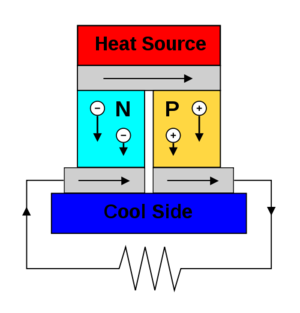Thermoelectric Generators: Difference between revisions
No edit summary |
(→External links: 2019 list of commercially available and soon to be available thermal to electrical energy conversion technologies) |
||
| (6 intermediate revisions by 2 users not shown) | |||
| Line 1: | Line 1: | ||
Thermoelectric | [[File:500px-Thermoelectric Generator Diagram.svg.png|thumb|right|A thermoelectric circuit composed of materials of different [https://en.wikipedia.org/wiki/Seebeck_effect Seebeck] coefficient (p-doped and n-doped semiconductors), configured as a thermoelectric generator.]] | ||
== Thermoelectric (TE) effect == | |||
Thermoelectric materials generate power directly from heat by converting temperature differences into electric voltage. A thermoelectric module is a circuit containing thermoelectric materials that generate electricity from heat directly. It consists of two dissimilar thermoelectric materials joining in their ends: an n-type (negatively charged); and a p-type (positively charged) semiconductors. | |||
== TE devices - characteristics == | |||
* This can potentially be very inexpensive if low-cost TE generators can be fabricated. | |||
* TE generators have great potential for reliable conversion of heat to electricity. For example: [http://www.tegpower.com/ TEG Power Info] lists a 50 Watt 12V unit. If you get 20 and hook them up to a [[gasifier]] then you have something that can do useful work. It has one moving part. Which is a small easily replaceable cooling pump. These will last 20+ years and '''reliably''' produce power. | |||
==Marcin Comment== | |||
that | This is excellent. Do you have practical experience with these? Can you lead a design effort to produce a robust, replicable TEG system? The heat sinking and packaging issues are not trivial in terms of making lifetime design systems, so that is why we have stayed away from these. Are you familiar with how to manufacture these? That would be very valuable information for resilient community enterprise. | ||
= | <html> | ||
<iframe width="420" height="315" align=right src="https://www.youtube.com/embed/XK6wmRVX6Uc" frameborder="0" allowfullscreen></iframe> | |||
</html> | |||
== Applications and Product Ecology == | |||
* this concept works on the temperature differential. Therefore, not just heat but also cooling is often required, so that the "cool" side of the device does not overheat, erasing the differential. Some devices on the market solve this by adding a fan (requiring electricity). Another possibility is to use water for cooling. | |||
* is small scale production possible ? practical materials required. | |||
* TE effect for small-scale '''solar thermal''' electricity (see: [[heliostat]]) | |||
* heat from biomass (combustion; pyrolysis, see: [[biochar]]) | |||
* co-generation at the very small (household) scale: space heating and electricity | |||
== External links == | |||
* Wikipedia: [http://en.wikipedia.org/wiki/Thermoelectric Thermoelectric materials] and [http://en.wikipedia.org/wiki/Thermoelectric_generator Thermoelectric generator] | |||
* Phys.Org article: [http://phys.org/news/2014-12-thermoelectric-power-economically-competitive-renewable.html "Thermoelectric power plants could offer economically competitive renewable energy"] | |||
[[Category: | *[1] 2019 list of commercially available and soon to be available thermal to electrical energy conversion technologies | ||
[[Category:Energy]][[Category:Solar Power]] | |||
Latest revision as of 22:35, 20 December 2019

Thermoelectric (TE) effect
Thermoelectric materials generate power directly from heat by converting temperature differences into electric voltage. A thermoelectric module is a circuit containing thermoelectric materials that generate electricity from heat directly. It consists of two dissimilar thermoelectric materials joining in their ends: an n-type (negatively charged); and a p-type (positively charged) semiconductors.
TE devices - characteristics
- This can potentially be very inexpensive if low-cost TE generators can be fabricated.
- TE generators have great potential for reliable conversion of heat to electricity. For example: TEG Power Info lists a 50 Watt 12V unit. If you get 20 and hook them up to a gasifier then you have something that can do useful work. It has one moving part. Which is a small easily replaceable cooling pump. These will last 20+ years and reliably produce power.
Marcin Comment
This is excellent. Do you have practical experience with these? Can you lead a design effort to produce a robust, replicable TEG system? The heat sinking and packaging issues are not trivial in terms of making lifetime design systems, so that is why we have stayed away from these. Are you familiar with how to manufacture these? That would be very valuable information for resilient community enterprise.
Applications and Product Ecology
- this concept works on the temperature differential. Therefore, not just heat but also cooling is often required, so that the "cool" side of the device does not overheat, erasing the differential. Some devices on the market solve this by adding a fan (requiring electricity). Another possibility is to use water for cooling.
- is small scale production possible ? practical materials required.
- TE effect for small-scale solar thermal electricity (see: heliostat)
- heat from biomass (combustion; pyrolysis, see: biochar)
- co-generation at the very small (household) scale: space heating and electricity
External links
- Wikipedia: Thermoelectric materials and Thermoelectric generator
- Phys.Org article: "Thermoelectric power plants could offer economically competitive renewable energy"
- [1] 2019 list of commercially available and soon to be available thermal to electrical energy conversion technologies